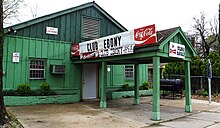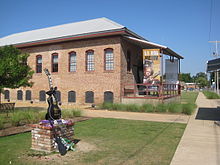City in Mississippi, United States
| Indianola, Mississippi | |
|---|---|
| City | |
 | |
 Flag Flag Seal Seal | |
 Location of Indianola, Mississippi Location of Indianola, Mississippi | |
 | |
| Coordinates: 33°27′04″N 90°38′15″W / 33.45111°N 90.63750°W / 33.45111; -90.63750 | |
| Country | United States |
| State | Mississippi |
| County | Sunflower |
| Government | |
| • Mayor | Ken Featherstone (D) |
| Area | |
| • Total | 8.66 sq mi (22.42 km) |
| • Land | 8.57 sq mi (22.20 km) |
| • Water | 0.09 sq mi (0.23 km) |
| Elevation | 121 ft (37 m) |
| Population | |
| • Total | 9,646 |
| • Density | 1,125.42/sq mi (434.53/km) |
| ZIP codes | 38751 |
| FIPS code | 28-34740 |
| GNIS feature ID | 2404760 |
| Website | www |
Indianola is a city in and the county seat of Sunflower County, Mississippi, United States, in the Mississippi Delta. The population was 10,683 at the 2010 census.
History
In 1891, Minnie M. Cox was appointed postmaster of Indianola, becoming the first black female postmaster in the United States. Her rank was raised from fourth class to third class in 1900, and she was appointed to a full four-year term. Cox's position was one of the most respected and lucrative public posts in Indianola, as it served approximately 3,000 patrons and paid $1,100 annually, then a large sum. White resentment to Cox's prestigious position began to grow, and in 1902 some white residents in Indianola drew up a petition requesting Cox's resignation. James K. Vardaman, editor of The Greenwood Commonwealth and a white supremacist, began delivering speeches reproaching the people of Indianola for "tolerating a negro wench as a postmaster."
Racial tensions grew, and threats of physical harm led Cox to submit her resignation to take effect on January 1, 1903. The incident attracted national attention, and President Theodore Roosevelt refused to accept her resignation, feeling Cox had been wronged, and the authority of the federal government was being compromised. "Roosevelt stood resolute. Unless Cox's detractors could prove a reason for her dismissal other than the color of her skin, she would remain the Indianola postmistress."
Roosevelt closed Indianola's post office on January 2, 1903, and rerouted mail to Greenville; Cox continued to receive her salary. The same month, the United States Senate debated the Indianola postal event for four hours, and Cox left Indianola for her own safety and did not return. In February 1904, the post office was reopened but was demoted in rank from third class to fourth class.
In July 1954, two months after the Supreme Court of the United States announced its unanimous decision in Brown v. Board of Education, ruling that school segregation was unconstitutional, the local plantation manager Robert B. Patterson met with a group of like-minded people in a private home in Indianola to form the White Citizens' Council.
In May 2023, the police's shooting of Aderrien Murry, an 11-year-old, occurred in the city.
Geography
Indianola is 30 miles (48 km) west of Greenwood.
Climate
The climate in this area is characterized by hot, humid summers and generally mild to cool winters. According to the Köppen Climate Classification system, Indianola has a humid subtropical climate, abbreviated "Cfa" on climate maps.
Demographics
| Census | Pop. | Note | %± |
|---|---|---|---|
| 1890 | 249 | — | |
| 1900 | 630 | 153.0% | |
| 1910 | 1,098 | 74.3% | |
| 1920 | 2,112 | 92.3% | |
| 1930 | 3,116 | 47.5% | |
| 1940 | 3,604 | 15.7% | |
| 1950 | 4,369 | 21.2% | |
| 1960 | 6,714 | 53.7% | |
| 1970 | 8,947 | 33.3% | |
| 1980 | 8,050 | −10.0% | |
| 1990 | 11,809 | 46.7% | |
| 2000 | 12,066 | 2.2% | |
| 2010 | 10,683 | −11.5% | |
| 2020 | 9,646 | −9.7% | |
| U.S. Decennial Census | |||
2020 census
| Race | Num. | Perc. |
|---|---|---|
| White | 1,038 | 10.76% |
| Black or African American | 8,236 | 85.39% |
| Native American | 5 | 0.05% |
| Asian | 71 | 0.74% |
| Other/Mixed | 155 | 1.61% |
| Hispanic or Latino | 141 | 1.46% |
As of the 2020 United States Census, there were 9,646 people, 3,483 households, and 2,209 families residing in the city.
2000 census
As of the census of 2000, there were 12,066 people, 3,899 households, and 2,982 families living in the city. The population density was 1,400.3 inhabitants per square mile (540.7/km). There were 4,118 housing units at an average density of 477.9 per square mile (184.5/km). The racial makeup of the city was 25.73% White, 73.38% African American, 0.01% Native American, 0.46% Asian American, 0.16% from other races, and 0.27% from two or more races. Hispanic or Latino of any race were 0.71% of the population.
1990 census
As of the census of 1990, there were 11,809 people. The racial makeup of the city was 65.69% (7,757) Black or African American, 33.39% (3,943) White, 0.14% (17) Native American, 0.19% (23) Asian American, and 0.03% (4) from other races. 0.55% (65) were Hispanic or Latino of any race.
Economy
Because Indianola is located at the intersection of U.S. Route 49W and U.S. Route 82, as of 2004 it is one of the last economically viable small towns in the Mississippi Delta. In the 1980s and 1990s, the city government convinced a major retailer to build a distribution center near the intersection of the two highways. This development infused cash into the local economy and allowed semiskilled jobs to be established.
In August 2011, Delta Pride, a catfish processing company, closed its plant in Indianola.
Culture


J. Todd Moye, author of Let the People Decide: Black Freedom and White Resistance Movements in Sunflower County, Mississippi, 1945–1986, said that "Life in Indianola still moves at a pace established by its distinguishing characteristic, the picturesque and languid Indian Bayou that winds through downtown."
Blues
Indianola is the birthplace of the blues musician Albert King. The blues harp player, Little Arthur Duncan, was born in Indianola in 1934.
B.B. King grew up in Indianola as a child. He came to the blues festival named after him every year. King referenced the city with the title of his 1970 album Indianola Mississippi Seeds. The B.B. King Museum and Delta Interpretive Center, a $14 million facility dedicated to King and the blues, opened in September 2008.
Education
The Sunflower County Consolidated School District, headquartered in Indianola, operates public schools serving the city. Residents are zoned to Lockard Elementary School (K-2), Carver Elementary School (3-6), Robert L. Merritt Junior High School (7-9), and Gentry High School (10-12). The district operates two other 10-12 schools in the city, Indianola Career and Technical Center and Indianola Academic Achievement Academy.
Indianola Academy, a private school and former segregation academy, is in Indianola. As of 2012 most white teenagers in Indianola attend Indianola Academy instead of the public high schools. Sarah Carr of The Atlantic explained that there are two explanations of why the private academies in Indianola and other towns still exist. One says that the public schools suffered from poor leadership and wrongdoing and that the private academies thrive because of the failings of the public schools, and the other says that the white leadership starved the public schools of resources after the academies were enacted, leading to the failings of the public schools.
The Sunflower County Library operates the Henry M. Seymour Library in Indianola, which houses its administrative headquarters.
History of education
Prior to the school district merger, the Sunflower County School District had its headquarters in the Sunflower County Courthouse in Indianola. The district's educational services building is along U.S. Route 49 West in Indianola.
As of 1996, 90 per cent of students in the Indianola School District were black. Most of the white students who attend Indianola public schools transfer to private schools by junior high school.
Government and infrastructure

The Mississippi Department of Corrections operates a probation and parole office in the Courthouse Annex in Indianola.
The United States Postal Service operates the Indianola Post Office. A mural, entitled White Gold in the Delta by WPA Section of Painting and Sculpture artist Beulah Bettersworth, was installed in the post office in 1939. It depicted cotton harvesting scenes. Murals were produced from 1934 to 1943 in the United States through the Section of Painting and Sculpture, later called the Section of Fine Arts, of the U.S. Treasury Department. The original artist Walter Anderson was unable to complete the mural, and Bettersworth was selected. The mural was eventually destroyed. In 2008, the building was named the Minnie Cox Post Office Building by an act of Congress.
Notable people
- Little Arthur Duncan, a harmonica player, singer, and songwriter.
- Vera Chandler Foster, an American social worker.
- Albert King, a blues guitarist and singer
- B.B. King, an American blues singer-songwriter, guitarist, and record producer.
- George Jackson, an American songwriter and singer.
- Edward A. Jones, an African-American author
- Micheal Spurlock, an American football wide receiver
- Mary Alice, was an American television, film, and stage actress.
- Mr. Bo, an American electric blues guitarist, singer and songwriter.
Transportation
Indianola Municipal Airport is located in unincorporated Sunflower County, near Indianola. and operated by the city.
Media
The Enterprise-Tocsin has its offices in Indianola.
In the media
- Art students at Gentry High School in Indianola earned a listing in Guinness World Records on June 7, 2003, by creating the world's largest comic strip in their school parking lot. The giant Lucky Cow comic strip was big enough to cover 35 school buses, measuring 135 ft. wide and 47.8 ft. high.
- The book Two years in the Mississippi Delta recounts Michael Copperman's stint with the Teach for America program in Indianola, renamed "Promise" in the book.
References
- "Mayor". www.indianolams.gov. September 9, 2016. Retrieved November 29, 2024.
- "Feathertone may become new mayor". The Delta News. October 14, 2021. Retrieved November 29, 2024.
- "2020 U.S. Gazetteer Files". United States Census Bureau. Archived from the original on October 27, 2021. Retrieved July 24, 2022.
- ^ U.S. Geological Survey Geographic Names Information System: Indianola, Mississippi
- "Find a County". National Association of Counties. Archived from the original on May 31, 2011. Retrieved June 7, 2011.
- Deanna Boyd and Kendra Chen. "Minnie M. Cox: A Postmaster's Story". The History and Experience of African Americans in America's Postal Service. Smithsonian National Postal Museum. Archived from the original on April 20, 2016. Retrieved April 3, 2013.
- Williams, Horace Randall and Ben Beard (2009). This Day in Civil Rights History. New South Books. p. 49.
- "Minnie Cox: A First for Mississippi". African American Registry. Archived from the original on February 7, 2012.
- Roberts, Gene and Hank Klibanoff (2006). The Race Beat: The Press, the Civil Rights Struggle, and the Awakening of a Nation. New York: Alfred A. Knopf. p. 66. ISBN 0-679-40381-7.
- Planas, Antonio; Pipia, Lindsey (May 25, 2023). "Investigation launched after 11-year-old who called 911 for help is shot by officer in Mississippi". NBC News. Archived from the original on May 26, 2023. Retrieved May 26, 2023.
- Rubin, Richard. "Should the Mississippi Files Have Been Re-opened? No, because Archived 2019-02-21 at the Wayback Machine." The New York Times. August 30, 1998. Retrieved on March 25, 2012.
- "Indianola, Mississippi Köppen Climate Classification (Weatherbase)". Weatherbase. Archived from the original on March 3, 2016. Retrieved May 24, 2018.
- "Decennial Census of Population and Housing by Decades". US Census Bureau. Archived from the original on July 6, 2022.
- "Explore Census Data". data.census.gov. Archived from the original on December 6, 2021. Retrieved December 6, 2021.
- "U.S. Census website". United States Census Bureau. Archived from the original on July 9, 2021. Retrieved January 31, 2008.
- ^ Moye, J. Todd. Let the People Decide: Black Freedom and White Resistance Movements in Sunflower County, Mississippi, 1945–1986. University of North Carolina Press, November 29, 2004. 28 Archived 2023-07-15 at the Wayback Machine. Retrieved from Google Books on February 26, 2012. ISBN 0-8078-5561-8, ISBN 978-0-8078-5561-4.
- Parham, Wayne. "Delta Pride closes its Indianola catfish plant." The Enterprise-Tocsin. Retrieved on August 16, 2011.
- Jason Ankeny. "Little Arthur Duncan". AllMusic. Archived from the original on July 15, 2023. Retrieved December 14, 2011.
- Havighurst, Craig (October 16, 2008). "B.B. King's Hometown Museum". The Wall Street Journal.
- "Schools Archived 2011-07-23 at the Wayback Machine." Indianola School District. Retrieved on August 17, 2010.
- Carr, Sarah. "In Southern Towns, 'Segregation Academies' Are Still Going Strong Archived 2020-07-27 at the Wayback Machine." The Atlantic. December 13, 2012. Retrieved on March 29, 2013.
- "Sunflower County Library Directory Archived 2017-08-16 at the Wayback Machine." Sunflower County Library. Retrieved on July 21, 2010.
- Home page Archived 2010-07-25 at the Wayback Machine. Sunflower County School District. Retrieved on August 17, 2010. "200 Main Street / Courthouse Indianola, Mississippi 38751"
- "Demographics for Sunflower County Schools Archived 2012-03-09 at the Wayback Machine." Sunflower County School District. Retrieved on August 17, 2010.
- "Educational Services Building Archived 2012-03-09 at the Wayback Machine." Sunflower County School District. Retrieved on August 17, 2010.
- Sanchez, Rene. "Academies Are Final Bastions Of Separateness Series: IN SEARCH OF THE SOUTH; SURVIVORS OF THE SIXTIES Series Number: 4/6 Archived 2012-11-03 at the Wayback Machine." The Washington Post. July 17, 1996. A01. Retrieved on August 17, 2010. "There are five public schools. Nearly nine of 10 students enrolled in them are black. And the small number of whites who do send their children to public schools usually switch to the academy once they reach junior high."
- "Sunflower County Archived 2010-04-09 at the Wayback Machine." Mississippi Department of Corrections. Retrieved on September 14, 2010.
- "Post Office Location - INDIANOLA Archived 2012-06-16 at the Wayback Machine." United States Postal Service. Retrieved on September 14, 2010.
- "Minnie Cox Post Office Building" Archived 2017-02-15 at the Wayback Machine. Congressional Record — House, July 14, 2008, H6418.
- Colin Larkin, ed. (1995). The Guinness Who's Who of Blues (Second ed.). Guinness Publishing. pp. 274/5. ISBN 0-85112-673-1.
- FAA Airport Form 5010 for IDL PDF - Retrieved on September 23, 2010.
- "Poplarville, Hattiesburg among airports receiving grants Archived 2012-02-28 at the Wayback Machine." WDAM. March 12, 2010. Retrieved on September 23, 2010.
- "about us." (Archive) The Enterprise-Tocsin. Retrieved on March 4, 2011. "Our office is located at 114 Main St, Indianola."
- "Mississippi Delta High School Students Set World Record For Largest Comic Strip". Markpett.com. Archived from the original on March 3, 2016. Retrieved August 1, 2014.
- Copperman, Michael (2016). Teacher: Two years in the Mississippi Delta. Jackson: University of Mississippi Press. ISBN 978-1-4968-1854-6. Archived from the original on July 15, 2023. Retrieved October 6, 2020.
- "On being half-Asian in the Mississippi Delta". Scalawag. June 8, 2016. Archived from the original on May 18, 2020. Retrieved January 20, 2019.
External links
| Indianola, Mississippi | |||
|---|---|---|---|
| Areas | |||
| Education |
| ||
| Transportation | |||
| Media | |||
| Landmarks | |||
| (*) The main campus is not in Indianola, but Indianola is within its service area | |||
| Municipalities and communities of Sunflower County, Mississippi, United States | ||
|---|---|---|
| County seat: Indianola | ||
| Cities |  | |
| Towns | ||
| Unincorporated communities | ||
| Ghost towns | ||
| Footnotes | ‡This populated place also has portions in an adjacent county or counties | |